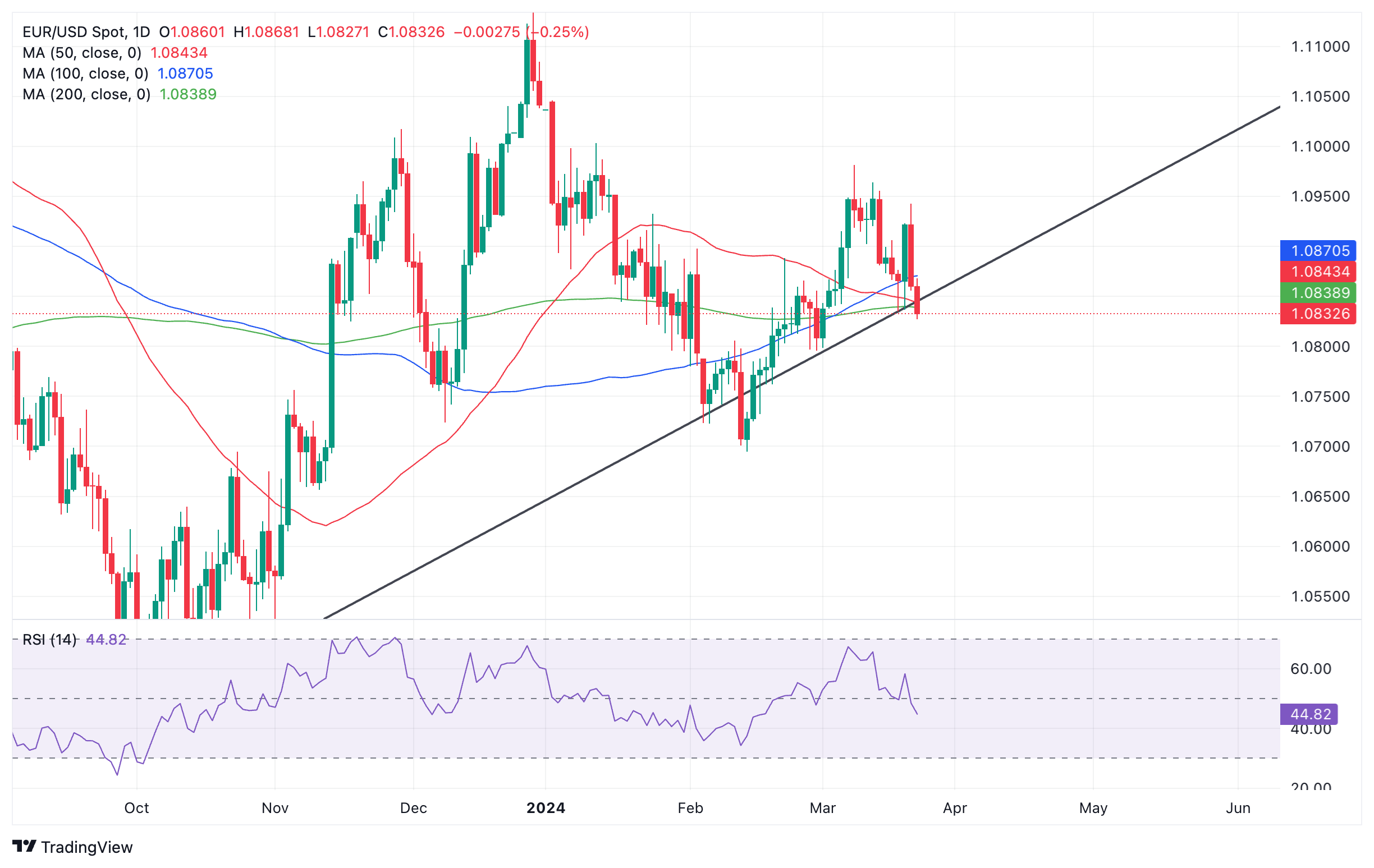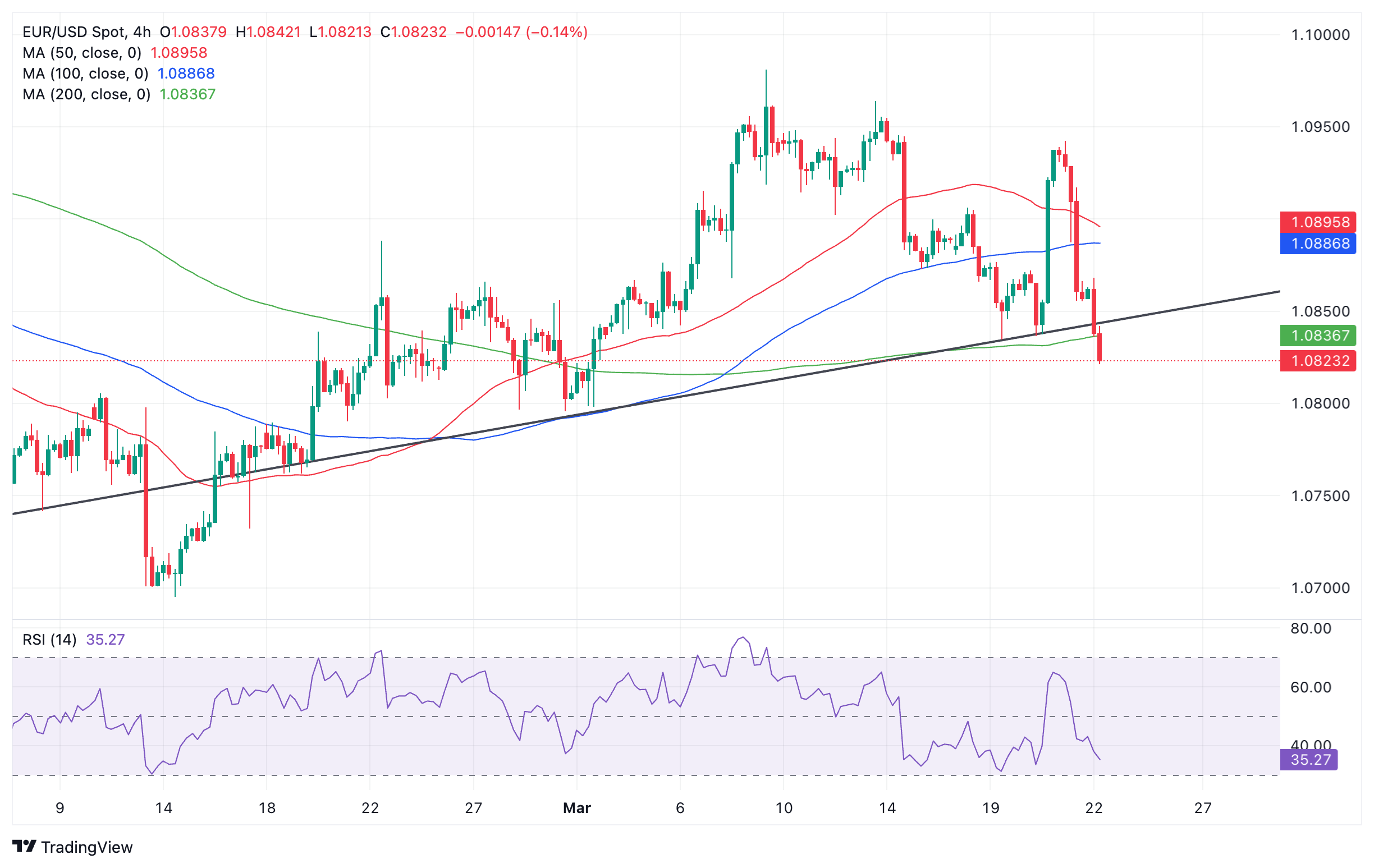- Analytics
- News and Tools
- Market News
- EUR/USD tests 200-day average with key Central bank speakers waiting in the wings
EUR/USD tests 200-day average with key Central bank speakers waiting in the wings
- EUR/USD is testing the key 200-day SMA on Friday after recapitulating over the prior sessions.
- The pair is poised to break below key support levels as key central bank figures line up to speak.
- Their commentary could impact expectations of when future interest rate cuts may take place.
EUR/USD is trading a quarter of a percent down on Friday, in the lower 1.0800s just below the 200-day Simple Moving Average (SMA). The pair has seen increased volatility since the Federal Reserve (Fed) policy meeting on Wednesday. The release of Eurozone and US flash PMI data for March on Thursday caused further volatility after the data showed the US economy in better shape than that of the euro area.
As traders wrap up for the weekend there is a heightened possibility of further moves as a roll call of central bank speakers take to the pulpit to share their views on Friday – from both the European Central Bank (ECB) and the Fed.
EUR/USD: A day of doves and hawks
EUR/USD exchanges hands in the 1.0830s as the European session on Friday gets underway. Key drivers for the pair at the end of the week will probably be commentary from central bankers. Several key figures are set to speak on monetary policy topics, including Bundesbank’s President Joachim Nagel, Fed’s Chairman Jerome Powell and ECB chief economist Philip Lane.
Their comments could impact the outlook for interest rates, which are set by central banks. Interest rates impact currencies because they dictate the level of foreign capital inflows from investors searching for returns. When interest rates are expected to go up it is positive for a currency; when down negative. Currently, the debate hinges around the timing of future rate cuts, with the consensus being that both the ECB and the Fed will make cuts in June. Anything that deviates from that view could cause volatility.
The first key central banker in the line up is the President of the Bundesbank, Joachim Nagel at 9:00 GMT who will be participating “in a webcast on monetary policy challenges and the economic outlook for the Eurozone and Germany,” according to the economic calendar.
His most recent comments suggested he is concerned about “Europe’s growth prospects more than his homeland” and back in February, he said the governing council should wait for Q2 wage data before deciding on whether to cut interest rates or not, suggesting he foresees June as a potential date for a rate-hike.
At 13:00 GMT, Federal Reserve Chairman Jerome Powell will participate in a “Fed Listens” panel about current economic conditions and how Covid impacted the economy. Vice-Chair Philip Jeffereson and Governor Michelle Bowman will also be at the event.
At 16:00 GMT, Federal Reserve Vice-Chair for Supervision Michael Barr will participate in a virtual discussion titled "International Economic and Monetary Design".
At 17:00 GMT , ECB Chief Economist and Board Member Philip Lane will deliver a policy lecture on inflation and monetary policy at the Aix-Marseille School of Economics (AMSE).
At 20:00 GMT, Federal Reserve Bank of Atlanta President Raphael Bostic will moderate a conversation about household finances at the 2024 Household Finance Conference – there is an outside chance he could mention interest rates.
Technical Analysis: EUR/USD tests trendline and 200-day SMA
EUR/USD is making volatile switches inside the 1.0800s and 1.0900s. It is currently trading back down in the 1.0800s just below the 200-day SMA at 1.0839, and a major trendline.
Euro versus US Dollar: Daily chart
The pair appears to be threatening to break below the trendline which could usher in a more bearish phase.
Such a move would be likely to tumble to at least 1.0775, the 0.618 Fibonacci extension of the move prior to the breakout lower, a common method of forecasting targets for trendline breaks.
The move down lacks momentum, however, as evidenced by the Relative Strength Index (RSI) on the 4-hour chart below, which shows RSI failing to reflect price’s current move down to a lower low – a suggestion bearish conviction is lacking.
Euro versus US Dollar: 4-hour chart
Whilst the lack of momentum does not completely preclude the expectation price will fall further, it brings in a note of caution and suggests bears should be careful not to be caught in what could potentially be a false break.
Euro FAQs
The Euro is the currency for the 20 European Union countries that belong to the Eurozone. It is the second most heavily traded currency in the world behind the US Dollar. In 2022, it accounted for 31% of all foreign exchange transactions, with an average daily turnover of over $2.2 trillion a day. EUR/USD is the most heavily traded currency pair in the world, accounting for an estimated 30% off all transactions, followed by EUR/JPY (4%), EUR/GBP (3%) and EUR/AUD (2%).
The European Central Bank (ECB) in Frankfurt, Germany, is the reserve bank for the Eurozone. The ECB sets interest rates and manages monetary policy. The ECB’s primary mandate is to maintain price stability, which means either controlling inflation or stimulating growth. Its primary tool is the raising or lowering of interest rates. Relatively high interest rates – or the expectation of higher rates – will usually benefit the Euro and vice versa. The ECB Governing Council makes monetary policy decisions at meetings held eight times a year. Decisions are made by heads of the Eurozone national banks and six permanent members, including the President of the ECB, Christine Lagarde.
Eurozone inflation data, measured by the Harmonized Index of Consumer Prices (HICP), is an important econometric for the Euro. If inflation rises more than expected, especially if above the ECB’s 2% target, it obliges the ECB to raise interest rates to bring it back under control. Relatively high interest rates compared to its counterparts will usually benefit the Euro, as it makes the region more attractive as a place for global investors to park their money.
Data releases gauge the health of the economy and can impact on the Euro. Indicators such as GDP, Manufacturing and Services PMIs, employment, and consumer sentiment surveys can all influence the direction of the single currency. A strong economy is good for the Euro. Not only does it attract more foreign investment but it may encourage the ECB to put up interest rates, which will directly strengthen the Euro. Otherwise, if economic data is weak, the Euro is likely to fall. Economic data for the four largest economies in the euro area (Germany, France, Italy and Spain) are especially significant, as they account for 75% of the Eurozone’s economy.
Another significant data release for the Euro is the Trade Balance. This indicator measures the difference between what a country earns from its exports and what it spends on imports over a given period. If a country produces highly sought after exports then its currency will gain in value purely from the extra demand created from foreign buyers seeking to purchase these goods. Therefore, a positive net Trade Balance strengthens a currency and vice versa for a negative balance.
© 2000-2024. Уcі права захищені.
Cайт знаходитьcя під керуванням TeleTrade DJ. LLC 2351 LLC 2022 (Euro House, Richmond Hill Road, Kingstown, VC0100, St. Vincent and the Grenadines).
Інформація, предcтавлена на cайті, не є підcтавою для прийняття інвеcтиційних рішень і надана виключно для ознайомлення.
Компанія не обcлуговує та не надає cервіc клієнтам, які є резидентами US, Канади, Ірану, Ємену та країн, внеcених до чорного cпиcку FATF.
Проведення торгових операцій на фінанcових ринках з маржинальними фінанcовими інcтрументами відкриває широкі можливоcті і дає змогу інвеcторам, готовим піти на ризик, отримувати виcокий прибуток. Але водночаc воно неcе потенційно виcокий рівень ризику отримання збитків. Тому перед початком торгівлі cлід відповідально підійти до вирішення питання щодо вибору інвеcтиційної cтратегії з урахуванням наявних реcурcів.
Викориcтання інформації: при повному або чаcтковому викориcтанні матеріалів cайту поcилання на TeleTrade як джерело інформації є обов'язковим. Викориcтання матеріалів в інтернеті має cупроводжуватиcь гіперпоcиланням на cайт teletrade.org. Автоматичний імпорт матеріалів та інформації із cайту заборонено.
З уcіх питань звертайтеcь за адреcою pr@teletrade.global.

















